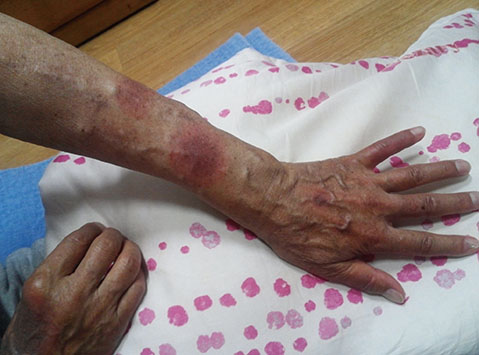Allergy Asthma Respir Dis.
2015 Sep;3(5):375-379. 10.4168/aard.2015.3.5.375.
Iodinated contrast media-induced fixed drug eruption
- Affiliations
-
- 1Department of Internal Medicine, Seoul National University College of Medicine, Seoul, Korea. helenmed@snu.ac.kr
- 2Institute of Allergy and Clinical Immunology, Seoul National University Medical Research Center, Seoul National University College of Medicine, Seoul, Korea.
- 3Regional Pharmacovigilance Center, Seoul National University Hospital, Seoul, Korea.
- KMID: 2218650
- DOI: http://doi.org/10.4168/aard.2015.3.5.375
Abstract
- Iodinated contrast media (ICM) can cause not only immediate onset hypersensitivity but also delayed onset hypersensitivity. While the most common form of delayed onset hypersensitivity reaction to ICM is exanthematous eruption, fixed drug eruption (FDE) can occur rarely related to ICM. A 70-year-old male with liver cirrhosis and hepatocellular carcinoma repeatedly experienced erythematous patches on his right forearm and hand 6 hours after exposure to iopromide for computed tomography scan. ICM induced FDE was diagnosed clinically. Intradermal test with 6 kinds of ICM (iobitridol, iohexol, iomeprol, iopamidol, iopromide, and iodixanol) was performed and showed the weakest positive reaction to iohexol compared to the others in 48 hours. After changing iopromide to iohexol based on these results, FDE did not recur. We report here a case of iopromide induced FDE which was successfully prevented by changing ICM to iohexol based on intradermal test results.
MeSH Terms
Figure
Reference
-
1. Shin MJ, Cho YJ. Management of adverse reaction to iodinated radiocontrast media. J Korean Med Assoc. 2012; 55:779–790.
Article2. Jung JW, Cho SH, Kim KH, Min KU, Kang HR. Clinical features of fixed drug eruption at a tertiary hospital in Korea. Allergy Asthma Immunol Res. 2014; 6:415–420.
Article3. Cha SH, Kim HS, Lee JY, Kim HO, Park YM. Fixed drug eruption due to iopromide (Ultravist). Ann Dermatol. 2011; 23:Suppl 1. S33–S35.
Article4. Kim MH, Lee SY, Lee SE, Kim MY, Jo EJ, Park CM, et al. Clinical features of delayed contrast media hypersensitivity. Allergy Asthma Respir Dis. 2014; 2:352–357.
Article5. Shiohara T, Mizukawa Y. Fixed drug eruption: the dark side of activation of intraepidermal CD8+ T cells uniquely specialized to mediate protective immunity. Chem Immunol Allergy. 2012; 97:106–121.
Article6. Hosoya T, Yamaguchi K, Akutsu T, Mitsuhashi Y, Kondo S, Sugai Y, et al. Delayed adverse reactions to iodinated contrast media and their risk factors. Radiat Med. 2000; 18:39–45.7. Benson PM, Giblin WJ, Douglas DM. Transient, nonpigmenting fixed drug eruption caused by radiopaque contrast media. J Am Acad Dermatol. 1990; 23(2 Pt 2):379–381.
Article8. Bohm I, Medina J, Prieto P, Block W, Schild HH. Fixed drug eruption induced by an iodinated non-ionic X-ray contrast medium: a practical approach to identify the causative agent and to prevent its recurrence. Eur Radiol. 2007; 17:485–489.
Article9. Frias M, Fernandez E, Audicana MT, Longo N, Munoz D, Reyes SM. Fixed drug eruption caused by iodinated contrast media. Contact Dermatitis. 2011; 65:43–44.
Article10. Le Beller C, Fraitag S, Jacquot C, Lillo-Le Louet A, Auffret N. Fixed drug eruption caused by iodixanol. Ann Dermatol Venereol. 2008; 135:684–685.11. Watanabe H, Sueki H, Nakada T, Akiyama M, Iijima M. Multiple fixed drug eruption caused by iomeprol (Iomeron), a nonionic contrast medium. Dermatology. 1999; 198:291–294.
Article12. Wright NA, Cohen PR. Fixed drug eruption associated with intravenous contrast media: report in a woman receiving iohexol. J Drugs Dermatol. 2011; 10:802–804.13. Yamauchi R, Morita A, Tsuji T. Fixed drug eruption caused by iopamidol, a contrast medium. J Dermatol. 1997; 24:243–245.
Article14. Jin SY, Kim DH, Choi YS, Kwon JH, Lee AY, Lee SH. Iodixanol-induced fixed drug eruption diagnosed by systemic provocation test. Korean J Dermatol. 2012; 50:1073–1076.15. Brockow K. Immediate and delayed reactions to radiocontrast media: is there an allergic mechanism? Immunol Allergy Clin North Am. 2009; 29:453–468.
Article
- Full Text Links
- Actions
-
Cited
- CITED
-
- Close
- Share
- Similar articles
-
- Iodixanol-Induced Fixed Drug Eruption Diagnosed by Systemic Provocation Test
- Recent Updates on Diagnosis and Prevention of Hypersensitivity Reactions to Iodinated Contrast Media
- Endoscopic Retrograde Cholangiopancreatography Using Barium Sulfate As a Contrast Material
- Transient Orbitofacial Angioedema due to Intravenous Iodinated Contrast Media During Computed Tomography: CT Findings
- An experimental study on renal damage induced by ionic contrast media in relation to iodine concentration


